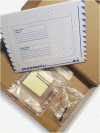From disgusting and complicated to simple and brilliant: Implementation perspectives and lessons learned from users and rejectors of mail-in SARS-CoV-2 gargle tests
- PMID: 36684995
- PMCID: PMC9850099
- DOI: 10.3389/fpubh.2022.1024525
From disgusting and complicated to simple and brilliant: Implementation perspectives and lessons learned from users and rejectors of mail-in SARS-CoV-2 gargle tests
Abstract
Background: Despite the important role of testing as a measure against the COVID-19 pandemic, user perspectives on SARS-CoV-2 tests remain scarce, inhibiting an improvement of testing approaches. As the world enters the third year of the pandemic, more nuanced perspectives of testing, and opportunities to expand testing in a feasible and affordable manner merit consideration.
Methods: Conducted amid the second pandemic wave (late 2020-early 2021) during and after a multi-arm trial evaluating SARS-CoV-2 surveillance strategies in the federal state Baden-Württemberg, Germany, this qualitative sub-study aimed to gain a deeper understanding of how test users and test rejectors perceived mail-in SARS-CoV-2 gargle tests. We conducted 67 semi-structured in-depth interviews (mean duration: 60 min) via telephone or video call. Interviews were audio-recorded, transcribed verbatim and analyzed inductively using thematic analysis. The Consolidated Framework for Implementation Research guided the findings' presentation.
Results: Respondents generally described gargle sampling as simple and comfortable. However, individual perceptions of the testing method and its feasibility varied widely from disgusting and complicated to simple and brilliant. Self-sampling was appreciated for lowering infection risks during testing, but also considered more complex. Gargle-sampling increased participants' self-efficacy to sample correctly. Communication (first contact, quantity and content of information, reminders, support system) and trust (in the study, its institutional affiliation and test method) decisively influenced the intervention's acceptability.
Conclusion: User-driven insights on how to streamline testing include: consider communication, first impressions of tests and information as key for successful mail-in testing; pay attention to the role of mutual trust between those taking and administering tests; implement gargle self-sampling as a pleasant alternative to swab testing; offer multiple test methods to increase test up-take.
Keywords: COVID-19; SARS-CoV-2; gargle test; implementation study; mail-in tests; self-sampling; test rejector perspectives; test user perspectives.
Copyright © 2023 Röhr, Uellner, Deckert, Anders, Burk, Knop, Brugnara, Bärnighausen, Jahn, McMahon and Souares.
Conflict of interest statement
LB was employed Evaplan Ltd. The remaining authors declare that the research was conducted in the absence of any commercial or financial relationships that could be construed as a potential conflict of interest.
Figures
Similar articles
-
Comparison of Four Active SARS-CoV-2 Surveillance Strategies in Representative Population Sample Points: Two-Factor Factorial Randomized Controlled Trial.JMIR Public Health Surveill. 2023 Aug 17;9:e44204. doi: 10.2196/44204. JMIR Public Health Surveill. 2023. PMID: 37235704 Free PMC article. Clinical Trial.
-
Effectiveness and cost-effectiveness of four different strategies for SARS-CoV-2 surveillance in the general population (CoV-Surv Study): a structured summary of a study protocol for a cluster-randomised, two-factorial controlled trial.Trials. 2021 Jan 8;22(1):39. doi: 10.1186/s13063-020-04982-z. Trials. 2021. PMID: 33419461 Free PMC article.
-
[Continuous SARS-CoV-2 monitoring in day care centres: A qualitative interview study on the experiences of childcare workers and parents with different self-sampling methods in the home environment].Z Evid Fortbild Qual Gesundhwes. 2024 Sep;189:24-32. doi: 10.1016/j.zefq.2024.07.002. Epub 2024 Aug 20. Z Evid Fortbild Qual Gesundhwes. 2024. PMID: 39164131 German.
-
Detection of SARS-CoV-2 Infection in Gargle, Spit, and Sputum Specimens.Microbiol Spectr. 2021 Sep 3;9(1):e0003521. doi: 10.1128/Spectrum.00035-21. Epub 2021 Aug 25. Microbiol Spectr. 2021. PMID: 34431686 Free PMC article.
-
Saliva as a sample type for SARS-CoV-2 detection: implementation successes and opportunities around the globe.Expert Rev Mol Diagn. 2022 May;22(5):519-535. doi: 10.1080/14737159.2022.2094250. Epub 2022 Jul 4. Expert Rev Mol Diagn. 2022. PMID: 35763281 Review.
Cited by
-
Comparison of Four Active SARS-CoV-2 Surveillance Strategies in Representative Population Sample Points: Two-Factor Factorial Randomized Controlled Trial.JMIR Public Health Surveill. 2023 Aug 17;9:e44204. doi: 10.2196/44204. JMIR Public Health Surveill. 2023. PMID: 37235704 Free PMC article. Clinical Trial.
-
Scalable RT-LAMP-based SARS-CoV-2 testing for infection surveillance with applications in pandemic preparedness.EMBO Rep. 2023 May 4;24(5):e57162. doi: 10.15252/embr.202357162. Epub 2023 Mar 23. EMBO Rep. 2023. PMID: 36951170 Free PMC article.
-
Acceptability of self-sampling and self-testing for infections: a rapid systematic review on public users' views.BMC Public Health. 2025 Feb 20;25(1):695. doi: 10.1186/s12889-025-21773-w. BMC Public Health. 2025. PMID: 39972444 Free PMC article.
References
-
- World Health Organization (WHO) . Recommendations for National SARS-CoV-2 Testing Strategies and Diagnostic Capacities: Interim Guidance, 25 June 2021. Available online at: https://www.who.int/publications/i/item/WHO-2019-nCoV-lab-testing-2021.1... (accessed March 18, 2022).
-
- Lopez Bernal J, Andrews N, Gower C, Robertson C, Stowe J, Tessier E, et al. . Effectiveness of the Pfizer-BioNTech and Oxford-AstraZeneca vaccines on covid-19 related symptoms, hospital admissions, and mortality in older adults in England: test negative case-control study. BMJ. (2021) 373:n1088. 10.1136/bmj.n1088 - DOI - PMC - PubMed
Publication types
MeSH terms
LinkOut - more resources
Full Text Sources
Medical
Research Materials
Miscellaneous



